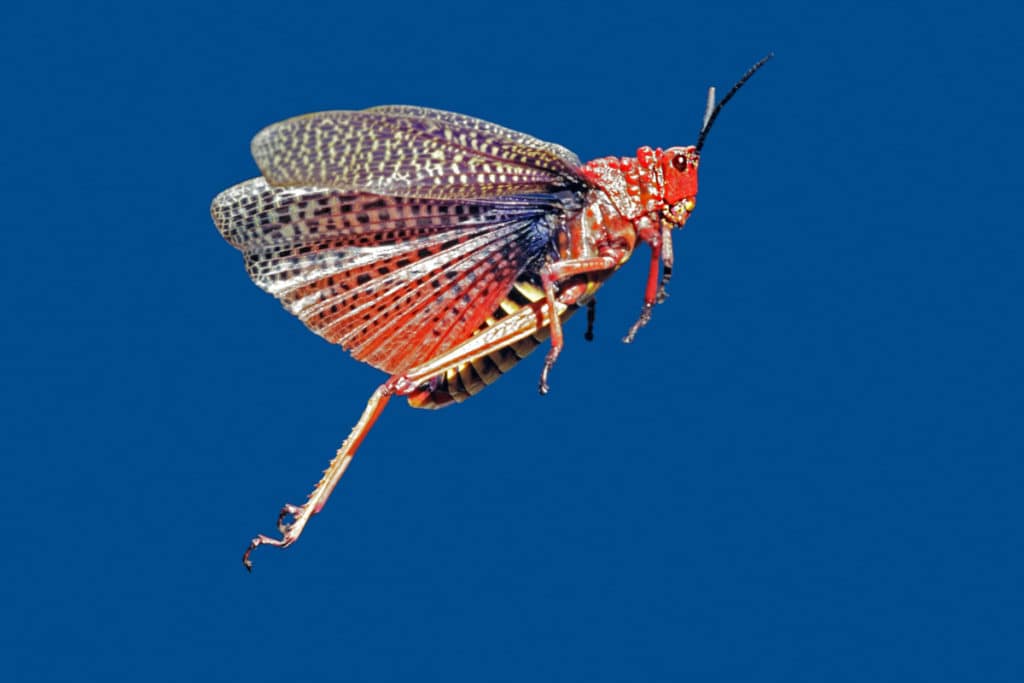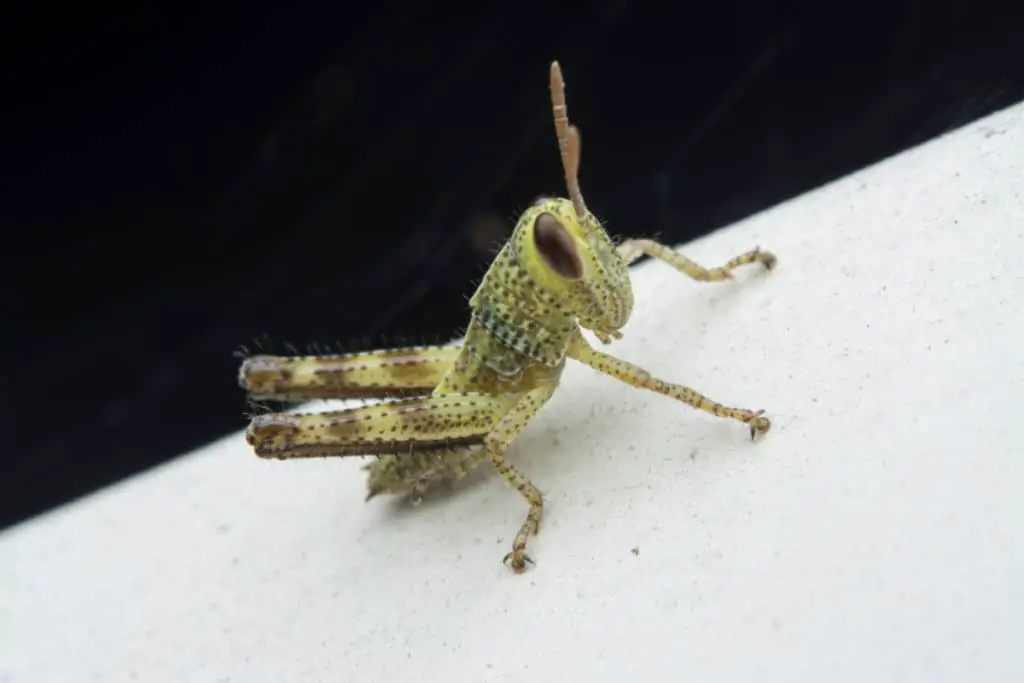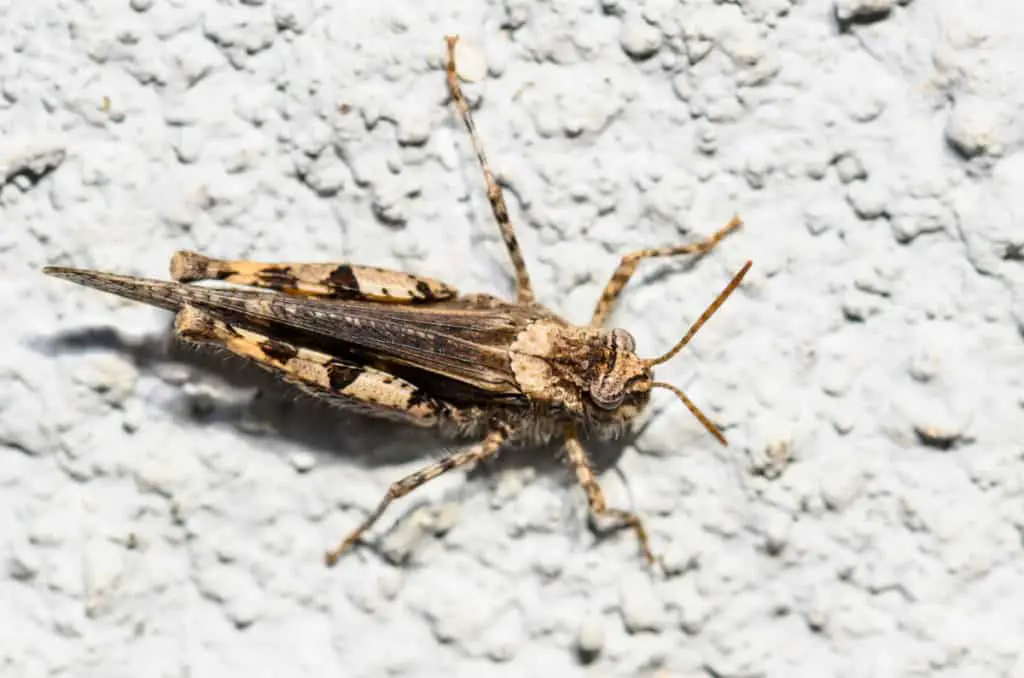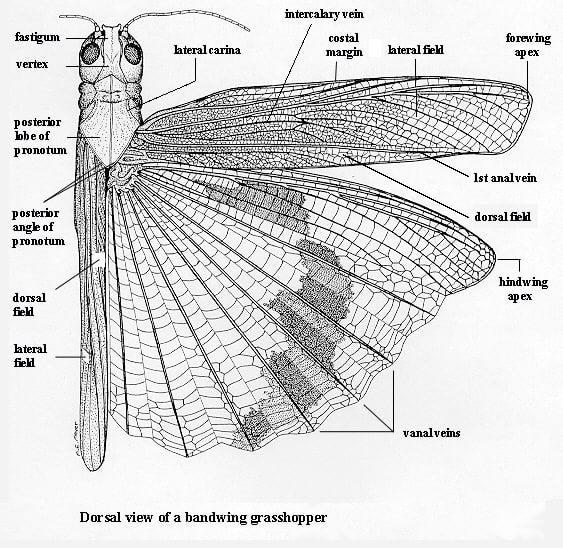It’s pretty much obvious by their name that they can hop. Packed with powerful hind legs, grasshoppers can catapult themselves high into the air.
But have you ever wondered if they can also fly?
Most (but not all) grasshoppers have 2 pairs of wings. Their powerful back legs help launch them into flight, in the air their wings take over. Grasshoppers use flight to escape predators or in search of food. Swarms of grasshoppers (or locusts) can fly up to 1000m and remain in the air for 3 days.

Below we will discuss the wings of grasshoppers in detail, how they work, and what they are used for, as well as answer some interesting questions about the flight of the grasshopper and its wings.
A Look At The Anatomy Of A Grasshoppers Wings
Orthoptera (grasshoppers) usually have two pairs of wings. These pairs usually comprise a small, narrow, and leathery forewing (known as the tegmina), as well as a fan-like hind wing which is covered by the front wing.
As can be seen in the diagram below, provided by North Dakota State University, on the forewing, the front, or leading edge of the wing is named the costal margin, and the hind edge is the inner margin.
The costal area the section immediately behind the coastal margin is often enlarged and crossed by a pattern of parallel veins.
These veins run in a diagonal pattern to the margin, which gives the costal area the appearance of small windows. These “windowed” areas are known as fenestrae.
In many species of grasshopper, a raised vein can be seen running parallel to the costal margin. This vein is known as the intercalary vein. Some species, such as the bandwing grasshoppers produce sound by rubbing their mind leg across this vein.
How Do Grasshopper Wings Work?
The thorax of the grasshopper is made up of three fused segments, including the prothorax, mesothorax, and metathorax.
The tegmina (leathery forewings) are attached to the mesothorax, and the membranous fan-like wings join at the metathorax.
The wings in grasshoppers, like those of other insects, are controlled by a series of muscles. These muscles are broken down into the following groups:
Direct Flight Muscles (DFM)
These muscles are connected directly to the wing base. The contraction of these muscles brings about the direct flapping of the wings and the rotation of the wings.
In grasshoppers, these muscles situated on the mesothorax are also used for walking.
Close Packed Muscles
These muscles are small interspaced myofibrils that are evenly spaced with mitochondria.
Synchronous Muscles
In these muscles the frequency of the nerve stimulation and contraction work in perfect harmony. These muscles are nonfibrillar and ancestral similar to asynchronous muscles.
These muscle groups work together in a pattern of flapping, as well as rotation which allows grasshoppers to take flight.
Certain species of grasshopper have more developed DFM muscles which aid them in longer flight, while others are able to only flutter short spaces at a time.
Furthermore, the DFM, or in grasshopper more commonly known as the DVM has been found to be multifunctional.
In some non-flying species, the same muscles are present.
When a study looked closer at these muscles in both flying and non-flying grasshopper species it was found that they have two functions, one was for flight, and the other was to aid movement in the legs.
Why Do Grasshoppers Fly?
Grasshoppers use their wings for two main reasons: as a protection method from predators, and for seasonal migration.
However, this doesn’t apply to all species, as some grasshoppers do not swarm, while others cannot fly at all.
Grasshopper Use Their Wings For Protection
There are two functional ways a grasshopper makes use of its wings for protection, although a third indirectly related protection method could be included.
Flight To Avoid Predators
Simply, a grasshopper can use its wings, in conjunction with its powerful hind legs, to jump and then fly out of harm’s way.
Having four individually controlled wings allows the grasshopper to change direction fairly quickly, and thus increasing its survival chance.
This is only true, however, for adult grasshoppers. Young grasshoppers, known as nymphs, cannot fly as they only develop their wings in the adult stage of their life cycle.
We have some data I another article about the survival rate of grasshoppers. You might be surprised how many don’t make it to adulthood. The article is called, How Long Do Grasshoppers Live?
Distracting Wing Colors
Some grasshoppers, such as the Mexican species taeniopoda auricornis flash their wings when startled. These wings tend to be brightly colored and therefore are distracting to a predator as it tries to catch the insect.
Wing Pattern Warnings
As a defense mechanism, some grasshopper species feed on plants, that when ingested, will make their predator ill. For this reason, certain predators will avoid eating them.
These species of grasshopper usually indicate themselves with particular markings on their body.
In some cases, these markings (often found on the wings) are mimicked by other grasshopper species to gain the same protection.
Grasshopper Wings For Swarming And Migration
When food sources become scarce or temperatures drop to an uncomfortably cold state, a grasshopper’s ability to fly allows it to move large distances in search of better land.
Similar to locusts, grasshoppers react to an increased level of serotonin (the same chemical that stimulates moods in humans).
Even with solitary grasshoppers, a gregarious state can form. During this time the behavior of the individual will change to match that of the surrounding grasshoppers.
It is common to find large swarms of grasshoppers traveling across fields and leaving devastation behind them.
What is more interesting is that each grasshopper will make these migrational patterns individually and on their path, but when coming into contact with a swarm will naturally adjust to fit into the swarm’s pattern and direction.
How High And How Far Can Grasshoppers Fly?
As with all species in the animal kingdom, the specifics will differ between each.
When in a swarm, grasshoppers can reach higher altitudes. This could be for the reasons of temperature regulation, as well as the aerodynamics and strip lines caused by the flying insects around them.
Some swarms have been known to reach heights of 1000 meters during nighttime periods.
Individual grasshoppers have been found to reach heights of 280 meters (920ft) without any problems.
The height that a grasshopper can reach is generally related to the size of the species. Smaller species may only be able to flutter a few feet high, or max out amongst the treetops.
Grasshoppers, while swarming, can cover an incredibly large amount of distance. According to facts.net a swarm of grasshoppers can remain airborne for up to three days before needing to touch the ground.
Another example of the exceptional flying capabilities of a grasshopper is seen in the Schistocerca gregaria which has been recorded to travel up to 100 km (60 miles) per day.
Can All Grasshoppers Fly?
The simplest answer to this question would probably be no.
The first thing to understand is that within the species of grasshoppers that do have the ability to stay airborne, it is only the adults that can do so.
When a grasshopper emerges from an egg it is known as a nymph. Nymph grasshoppers have neither the ability to reproduce nor to fly, due to their lack of wings. As a nymph grows it will go through a series of molts, eventually developing the wings which will allow it to take flight.
The full lifecycle of grasshopper is quite fascinating. Check it out if you like, we have a detailed article on, The Lifecycle of Grasshoppers.

Secondly, as mentioned before, not all species of grasshoppers develop functional wings. Although some species do not develop wings at all, others will grow wings that are too small to allow them to fly or to remain in the air.
Why Do Grasshoppers Pop And Snap While Flying?
The grasshopper’s “song” is one of nature’s best soundtracks right? But have you ever noticed how some grasshoppers make a loud clicking or snapping noise while flying and wondered what it was?
Remember the intercalary vein we mentioned above?
This vein is the primary source for this clicking sound that can be heard from some grasshoppers as they fly.
Some species, such as the aforementioned bandwing grasshopper will rub their hind legs on this vein during flight, while others will tense and release the membrane between this vein (as if opening and closing an umbrella), which results in the sound of a snap.

There are two reasons that this sound is created, one for the protection of its territory from other grasshoppers, as well as a startling noise towards predators.
The other, and most common use, is for the attraction of a mate. This is somewhat like a bird’s song to the female grasshopper.
We have more about how grasshoppers can hear each other in another article we have written called, Do Grasshoppers Have Ears?
The Wrap Up
Grasshoppers are well known for their ability to jump up to 200 times their body size, however, many people look over the fact that they can fly.
Although not all species of grasshoppers can fly, and only the adults in these species possess wings, grasshoppers are able to fly large distances in a very short amount of time.
The ability to fly aids grasshoppers both in the protection from predators, as well as allows them to migrate when temperatures drop or when food becomes scarce.
The next time you see a large insect fly past you, because it may be a grasshopper.
Sources
https://www.britannica.com/animal/band-winged-grasshopper
https://www.sciencedirect.com/topics/agricultural-and-biological-sciences/flight-muscles
https://www.sciencedirect.com/topics/agricultural-and-biological-sciences/myofibrils
https://jeb.biologists.org/content/jexbio/39/4/669.full.pdf
https://www.pnas.org/content/98/7/3895
https://citybugs.tamu.edu/2012/07/09/how-high-can-grasshoppers-fly/

